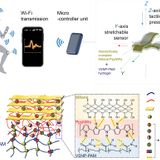RECENT ARTICLES

Mixed-dimensional MXene-hydrogel heterostructures for electronic skin sensors with ultrabroad working range
Skin-mountable microelectronics are garnering substantial interest for various promising applications including human-machine interfaces, biointegrated devices, and personalized medicine. However, it remains a critical challenge to develop e-skins to mimic the human somatosensory system in full working range. Here, we present a multifunctional e-skin system with a heterostructured configuration that couples vinyl-hybrid-silica nanoparticle (VSNP)–modified polyacrylamide (PAM) hydrogel with two-dimensional (2D) MXene through nano-bridging layers of polypyrrole nanowires (PpyNWs) at the...…Skin-mountable microelectronics are garnering substantial interest for various promising applications including human-machine interfaces, biointegrated devices, and personalized medicine. However, it remains a critical challenge to develop e-skins to mimic the human somatosensory system in full working range. Here, we present a multifunctional e-skin system with a heterostructured configuration that couples vinyl-hybrid-silica nanoparticle (VSNP)–modified polyacrylamide (PAM) hydrogel with two-dimensional (2D) MXene through nano-bridging layers of polypyrrole nanowires (PpyNWs) at the...WW…

Three-dimensional printing of functionally graded liquid crystal elastomer
As a promising actuating material, liquid crystal elastomer (LCE) has been intensively explored in building diverse active structures and devices. Recently, direct ink writing technique has been developed to print LCE structures with various geometries and actuation behaviors. Despite the advancement in printing LCE, it remains challenging to print three-dimensional (3D) LCE structures with graded properties. Here, we report a facile method to tailor both the actuation behavior and mechanical properties of printed LCE filaments by varying printing parameters. On the basis of the...…As a promising actuating material, liquid crystal elastomer (LCE) has been intensively explored in building diverse active structures and devices. Recently, direct ink writing technique has been developed to print LCE structures with various geometries and actuation behaviors. Despite the advancement in printing LCE, it remains challenging to print three-dimensional (3D) LCE structures with graded properties. Here, we report a facile method to tailor both the actuation behavior and mechanical properties of printed LCE filaments by varying printing parameters. On the basis of the...WW…
- Total 2 items
- 1